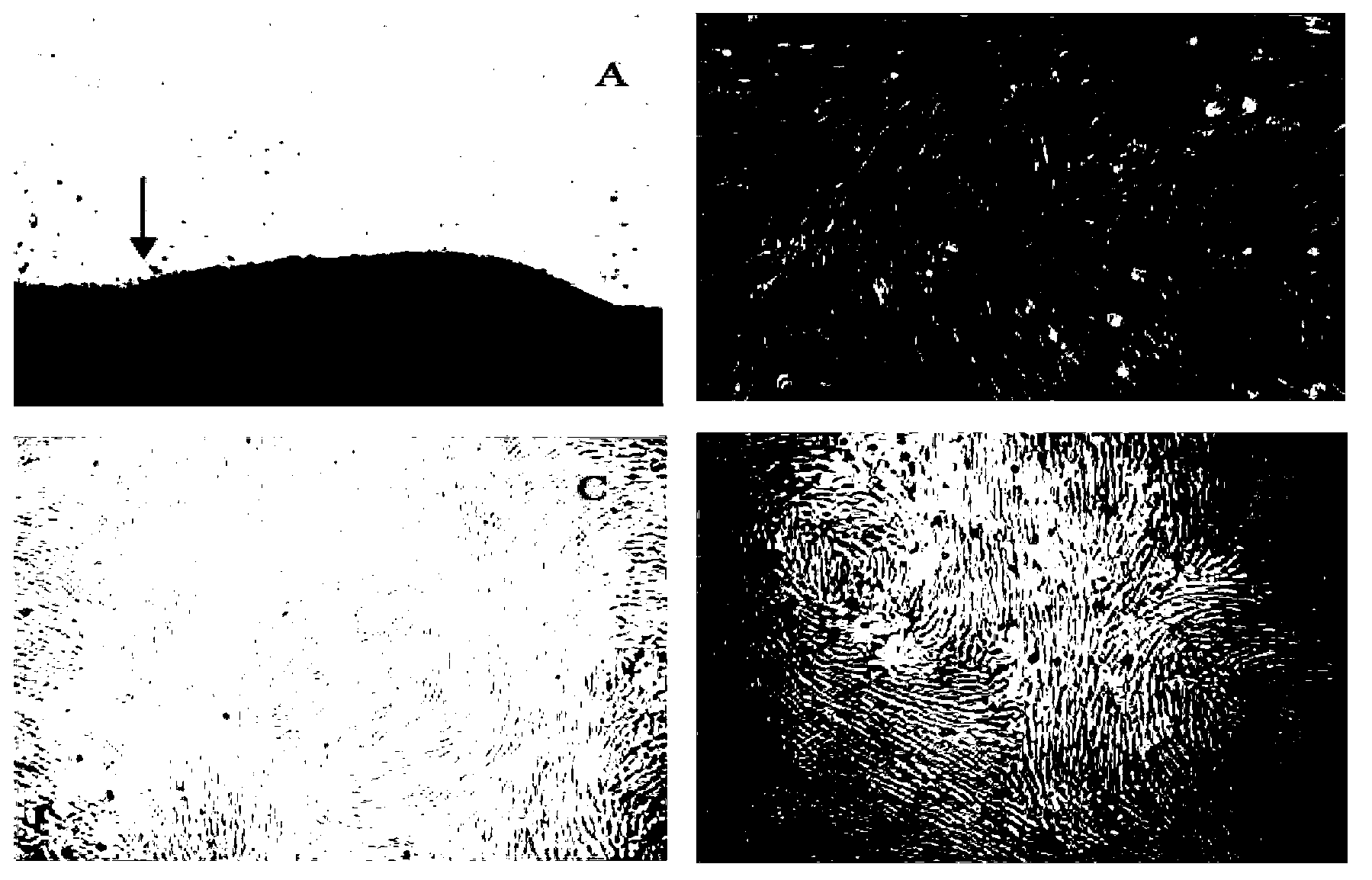Efficient method for isolating and culturing mesenchymal stem cells from umbilical cord
A technology for separating and culturing mesenchymal stem cells, applied in the field of isolating and culturing mesenchymal stem cells, which can solve the problems of difficult to separate mesenchymal stem cells, limited number of primary cells, difficult to separate stem cells, etc., to reduce pancreatic enzyme activity, operate Simple and easy to use, avoid the effect of the use of serum
- Summary
- Abstract
- Description
- Claims
- Application Information
AI Technical Summary
Problems solved by technology
Method used
Image
Examples
Embodiment 1
[0063] Example 1: Isolation and culture of human umbilical cord-derived mesenchymal stem cells
[0064] (1) Rinse the collected umbilical cord specimen with normal saline to remove residual blood. Weigh, measure the length, bluntly dissect the arteries, cut the rest of the umbilical cord tissue into 0.5-1cm segments, and put them in a new tissue processor (automatic tissue processor produced by Miltenyi, model: gentleMACSTM).
[0065] (2) Add type II collagenase (Sigma, C6885) at a final concentration of 0.1%, add hyaluronidase (Sigma, H4274) at a final concentration of 0.0005%, digest at 37°C for 60 min, and then stop digestion.
[0066] (3) Naturally settle for 8 minutes, transfer the supernatant cell suspension to a centrifuge tube, dilute with 2 times the volume of normal saline, centrifuge at 2000 rpm, 15°C for 20 minutes, and obtain a cell pellet; at the same time, dilute the undigested tissue pieces with normal saline Finally, centrifuge at 2000rpm at 15°C for 5min, di...
Embodiment 2
[0070] Example 2: Isolation and cultivation of human umbilical cord-derived mesenchymal stem cells
[0071] (1) Rinse the collected umbilical cord specimen with normal saline to remove residual blood. Weigh, measure the length, and bluntly dissect the arteries, cut the rest of the umbilical cord tissue into 0.5-1cm segments, and put them in a new tissue processor.
[0072] (2) Add type II collagenase at a final concentration of 0.05%, add hyaluronidase at a final concentration of 0.001%, digest at 37°C for 90min, and then stop digestion.
[0073] (3) Naturally settle for 10 minutes, transfer the supernatant cell suspension to a centrifuge tube, dilute with 5 times the volume of normal saline, centrifuge at 2500 rpm, 15°C for 15 minutes to obtain cell pellets; at the same time, dilute the undigested tissue pieces with normal saline Finally, centrifuge at 2000rpm at 15°C for 5min, discard the supernatant, and obtain undigested and complete tissue pieces for use.
[0074] (4) R...
Embodiment 3
[0077] Example 3: Isolation and cultivation of human umbilical cord-derived mesenchymal stem cells
[0078] (1) Rinse the collected umbilical cord specimen with normal saline to remove residual blood. Weigh, measure the length, and bluntly dissect the arteries, cut the rest of the umbilical cord tissue into 0.5-1cm segments, and put them in a new tissue processor.
[0079] (2) Add type II collagenase to a final concentration of 0.2%, add hyaluronidase to a final concentration of 0.001%, digest at 37°C for 60 minutes, and then stop digestion.
[0080] (3) Naturally settle for 10 minutes, transfer the supernatant cell suspension to a centrifuge tube, dilute with 5 times normal saline, centrifuge at 2500rpm, 15°C for 25 minutes to obtain cell pellets; meanwhile, dilute undigested tissue pieces with normal saline , 2000rpm, 15°C, centrifuge for 5min, discard the supernatant, and obtain undigested and complete tissue pieces for use.
[0081] (4) Resuspend the cell pellet obtained...
PUM
 Login to View More
Login to View More Abstract
Description
Claims
Application Information
 Login to View More
Login to View More - R&D
- Intellectual Property
- Life Sciences
- Materials
- Tech Scout
- Unparalleled Data Quality
- Higher Quality Content
- 60% Fewer Hallucinations
Browse by: Latest US Patents, China's latest patents, Technical Efficacy Thesaurus, Application Domain, Technology Topic, Popular Technical Reports.
© 2025 PatSnap. All rights reserved.Legal|Privacy policy|Modern Slavery Act Transparency Statement|Sitemap|About US| Contact US: help@patsnap.com



